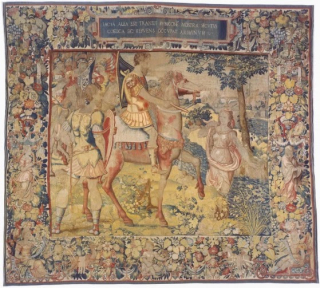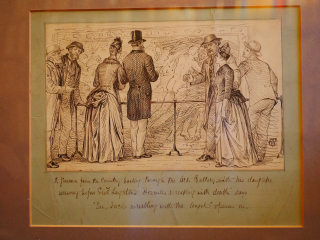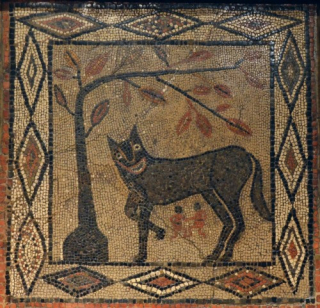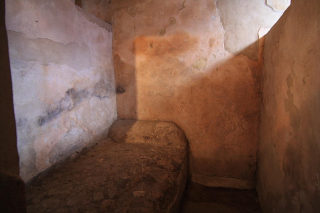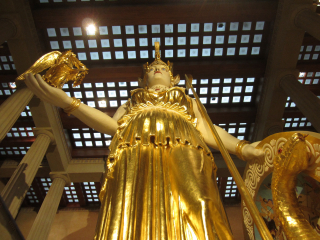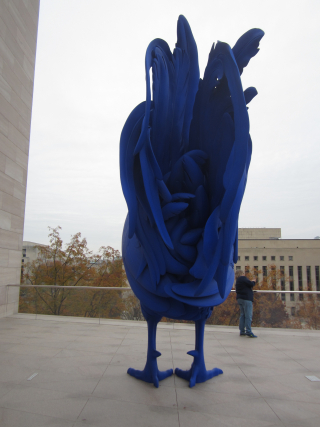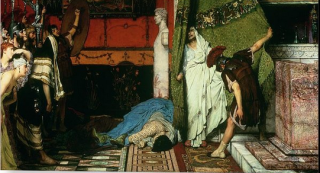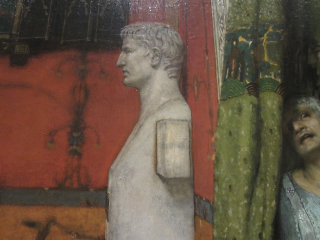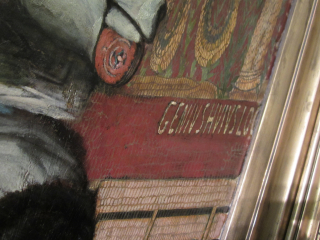Mary Beard's Blog, page 7
December 26, 2016
A "lost" Caesar tapestry
As every regular reader of this blog knows (probably more than they want to), I am working on images of The Twelve Caesars (the Suetonian set from Julius to Domitian) in later art.
One of my favourite case studies has been the lost set of Caesar tapestries commissioned from Henry VIII. None of these survive, but thanks to some brilliant work by Tom Campbell and others, their composition has been reconstructed through a series of later weavings up into the seventeenth century. The key article, not generally available online (but you can get it on JSTOR), is in Studies in the Decorative Arts vol 5, 1998.
The overall weaving history (on which I am no expert) seems to have been sorted out. But my own interest is in the iconography. And it is clear that here tapestry experts have missed a few tricks. To put it simply, it seems to me that the original weavings were based on designs drawn from Lucan���s Pharsalia, but as the captions of later weaving show, that became gradually reinterpreted as a series of illustrations of Suetonius��� Life of Caesar.
The really classic example of this is a clear design of Lucan���s witch Erichtho (being consulted by Pompey���s son, as in Lucan) being labelled in the captions of some later weavings as Spurina (the soothsayer who in Suetonius tells Caesar to ���beware the Ides of March���). The trouble is that Spurina was a man (despite the ���a��� ending of his name) and the figure illustrated is female.
My interest here is partly nerdy, and partly political. The idea of King Henry VIII���s walls being hung with scenes from one of the most mordant ancient critiques of autocratic power is an intriguing one.
Anyway a couple of months ago I was preparing a lecture partly on this subject and searching, as you do, through Google images I came across what looked like one of this series that I had not seen before. It was for sale in a New York carpet gallery and when I was shortly after in the USA I went to see it, with a friend.
It was a really impressive piece (to my untrained tapestry eye) and matched very closely one of the later weaving series of the 1560s-70s. If you can get the Campbell article it is a twin of fig 8, a scene of Caesar breaking into the treasury, auctioned in Berlin in 1935. It���s a nice piece in the jigsaw.
Anyway, when the word of this got out, I agreed to speak to a journalist ��� partly because it really is about time that tapestries get their share of the limelight. They were once the most prized items. Henry���s Caesar tapestries were the second most valuable item in the inventories of the royal possessions after the execution of Charles I (and the first most valuable item was also a tapestry set). Now people mostly walk past them in museums and galleries, despite some great recent work (of which I been a beneficiary). Here was a chance to give a tapestry a bit of publicity.
As I recall, I gave the story much as above, and responded negatively to some wilder speculations about the tapestries. And I insisted that M Beard should not emerge from this as some Indiana Jones style discover. Anyway, what appear is this article in the Times (to see it all, you need to subscribe) , and the BBC Radio news has an item on how Mary Beard has found one of Henry VIII���s lost tapestries. Aggghh.
To be fair to the writer of the article, he never actually says that I said that I had discovered Henry���s lost tapestry. But that is the strong impression that a quick reading would give you (as it gave the news broadcasters). The idea that this is a Henry original is ascribed to unnamed sources. I wonder who they were. I may not be skilled in tapestry dating and there is obviously a theoretical chance that I might be wrong. But the parallel with the Berlin is convincing to me and I would be decidedly unconvinced by any such claim (for that and other reasons).
I suppose that ���Cambridge prof discovers on Google a later version of a lost tapestry owned by Henry VIII��� isn���t much of a story. I should have known this, by now.
December 24, 2016
A Cartoon for Christmas
This year, the husband and I combined to give ourselves a present, the cartoon at the top of this post, bought at an auction (don���t think we���re getting above ourselves in the art investment market; there was plenty of change from ��100).
It is by someone we knew about as a stained glass maker, Thomas Camm, and hadn���t realised he extended much wider. This appears to be an original pen and ink drawing (though that���s a bit hard to say, as it is under glass: has anyone seen another version?) ��� on the subject of Frederic Leighton���s ���Hercules Wrestling with Death for the Body of Alcestis���, first exhibited at the Royal Academy in 1871. It���s now in Hartford, Connecticut.
The writing underneath the drawing reads as follows:
���A Farmer from the Country hasting through the Art Gallery with his daughter arriving before Sir F Leighton���s ���Hercules wrestling with Death��� says ���See, Jacob wrestling with the Angel��� & passes on.���
So what is the joke? One version in my house is that it is a joke on the stupidity of the country farmer, but that doesn���t quite deal with it. For example, what���s the role of the daughter here? The other version is that there is a joke about bums. The farmer dad is protecting his daughter from the erotic potential of Hercules, and neatly assuaging it by turning it into a biblical scene.
Any suggestions gratefully received.
(By the way, we are in the process of migrating this blog to a new system. There are one or two little glitches still to be sorted, but try it here.)
December 23, 2016
Roman history and the dangers of nostalgia
I���m not sure how we should feel about ancient Rome becoming an increasingly popular comparison for modern politics: both a mixture of delight and fear, I guess. . . and with a recognition that these comparisons tend to come in waves, and will retreat again soon.
But that fact is some heavyweights have been laying in more vociferously than in recent years, including Paul Krugman ���who has been comparing some aspects of modern American politics to the fall of the Roman Republic.
One of the main lessons he sees is: ���Republican institutions don���t protect against tyranny when powerful people start defying political norms.��� And he quotes Adrian Goldsworthy on the constraining rules that once governed Roman Republican politics, but no longer did by the time of its ���fall���: ���However important it was for an individual to win fame and add to his and his family���s reputation, this should always be subordinated to the good of the Republic ��� no disappointed Roman politician sought the aid of a foreign power.���
There is obviously something in this, but as with all such comparisons it conceals as much as it reveals.
For a start, even if the picture is broadly true, there is the obvious question of what caused the defiance against the traditional rules of political life? It wasn���t just that politicians started behaving worse, or were a generally more worthless lot. There were all kinds of other factors at play, which may -- or more likely may not -- be relevant. There was imperial expansion and huge issues about its governance, social and economic changes caused in part by the influx of slavery, which was one of the main ���profits��� of empire. (If anyone wants a quick guide to the complexity of all this, the first chapter of Keith Hopkins, Conquerors and Slaves is still one of the best.)
But there is also a question of what kind of historical change we are dealing with. OK, the Republic DID in the end collapse. But the nostalgic view (held by ancients and moderns alike) of the early and middle Roman Republic as a place where politics was done honourably and properly, unlike the later period, doesn���t stand up in its simple form.
Roman writers WANTED to believe that the end of the Republic was a violent overturning of an earlier consensus. That���s what Appian tried to claim when he wrote that the conflict over (and murder of) Tiberius Gracchus in the 130s BC was the first time ���daggers had entered the forum���.
Actually it wasn���t the first time. Roman history had been marked by internal violence from the very start. That���s what the story of Romulus and Remus (pictured in a British version above) is trying to say: fratricide is part and parcel of Rome. And it goes on through the rape of Lucretia, to the Struggle of the Orders (horrible civil strife hiding under a posh name), and beyond. Anyone who had read about the bitter battles of early Rome would have known that there had been class conflicts, sit-down strikes and civic dissent way long before the Republic fell. The peaceable earlier consensus was a myth.
And for us there is a problem of evidence too. The surviving letters of Cicero, with all their gossip and double-dealings, give a very strong picture of the self-interest and cutthroat quality that defines later Republican politics. How different, we think, from those honourable earlier days of the Scipios and their like.
But hang on. The reputation of the Scipios has probably been saved by the fact that we do NOT have their letters, which would presumably have revealed very similar kinds of bad behaviour, wheeling and dealing and back-stabbing.
It���s not that Roman politics didn���t change, but it wasn���t the simple picture of political and moral decline that it gets painted ��� especially when we want to use it as a comparison for our own.
December 18, 2016
"British values" mean thinking harder about "British values"
It is hard to believe that Sajid Javid has actually really thought through this proposal (if ���proposal��� it actually is) to make all public servants swear an oath (or presumably affirm if they prefer) that they will uphold the great British values of democracy, tolerance, freedom of speech etc.
Now I am not wholly unused to promise making. When you become a fellow of my college in Cambridge (and I suspect the same goes for others) you publicly promise to do various, well judged,things: to obey the Principal in the exercise of her statutory powers (the qualification is important: you don���t have to obey her tout court, and she doesn���t have that many statutory powers), and to uphold the college as a place of ���education, learning and research���. It���s a promise that does well enough in a small community, reasserting the values that those elected had anyway.
But it is a million miles away from the Javid proposals, which are the worst kind of knee-jerk reactions to a complicated problem, and much akin to the questions you get on visa application forms: ���Do you support terrorism?��� (Presumably if you turn out to be a terrorist, they get you for perjury as well). Or even more akin perhaps to what you swear or affirm in the witness box in court ��� and there it really a case not so much of a moral terror of telling an untruth, but a looming perjury trial.
But what Javid suggests may have well-meaning roots (yes, I also think that people living in the UK should speak English, and as many other languages as possible), but is plain silly. For a start, who counts as a public servant? I hope they wont have the nerve to impose this on university teachers, given the fact that we are now effectively paid for by the students.
But more to the point, it would be making people swear up to something much more contentious than education, learning and research (whose boundaries are capacious and only occasionally problematic��� ���I am spending every evening getting sloshed in the pub, as I am researching the culture of drunkenness��� . . . ??) Anyone who has thought about this a minute longer than Sajid Javid would realise, for example, that ���free speech��� was one of the most contentious of all modern slogans. It is used by some of the fiercest trolls online to justify spreading poison ��� while most of the rest of us would have no doubt that it was not the same as a licence to preach anything you fancied, but would differ on where the boundaries lay (from no platforming to anti-racism). And it���s a question as old as we can trace: Socrates, criminal or martyr?
What on earth is the point of making people mouth acceptance of such disputed platitudes? And it would be the same for ���democracy��� and ���tolerance��� (isn't sometimes ���no tolerance��� OK?).
Surely the point is that British values are a process not a thing one can avow on a tick box form. Or, as Lord West put it on the radio this morning, aren���t British values partly about not swearing an oath to uphold British values? And anyway, aren���t they brought more into disrepute by being mouthed as the price of a ���job��� as a public servant? And couldn���t the money (on drafting the damn oath, on creating the appeals procedure for the refuseniks, etc etc ) be better spent? Answer: yes.
December 16, 2016
How rude is too rude?
When AA Gill died a few days ago, I felt genuinely sad. He had been absolutely horrible to me in print, but I still felt sad. That wasn���t because he was a great writer. He sometimes was that, and he sometimes he wasn���t. But anyway, I am not sure that great writing is a get out of jail free card. To use a quite different analogy, we wouldn���t let a racist off the hook because he had a clever way with words.
I felt reasonably OK about him because his attacks on me were in a way genuine criticism, in an old tradition of invective, and they were signed ��� there was a head above the parapet. They were also in my view wrong and nastily sexist (I hadn���t recalled that he compared me to an aborted egg, but maybe he did). And in truth Gill got told he was a nasty sexist by very many people, and his wiki entry was ransacked. It was, and I suspect he would have agreed, all fair game: give as good as you get is one of the oldest answers to invective, and probably what the deliverer of invective would expect.
I didn���t end up holding any particular personal animus against Gill. I was really cross and a bit hurt at the time, and rather shocked that someone would think (as presumably he did) that that kind of talk would find a ready audience. But in the end I suspect he had a harder time than I did out of his attack and I would have liked to shake hands and discussed what he said. And for me ��� who knows full well what the nastiness of anonymous Twitter attacks can be (where you have no one to hold to account) ��� there was someone to fight back against (which I did).
But it does raise the question of what standards we expect in public disagreement.
I must confess that I really don���t fancy living in a world in which no one is ever rude to those they disagree with. A world of unending courtesy seems, if nothing else, dull. But the questions then are: what are the limits of rudeness, when does rudeness become discriminatory or hate crime, what resources do we have for responding or rejecting, and where does the defence of ���free speech��� run aground?
As I have said before, the basic rules in literary reviewing are pretty clear to me: only say what you would say to someone���s face (and I suspect Gill passed that test��� if he did say I looked like an aborted egg, he probably would have said that face to face). But that���s not all there is to it. We wouldn���t be having any such discussion as this, if Gill���s attack had been anti-semitic or racist. So why is sexism different? (That���s an open question: about where exactly the boundaries of the unacceptable and/or the illegal, and/or the simply rude lie.)
For me, though, there is a sting in the tail of Gill���s ���wit���, for which no one can blame him at all. Since his death there have been all kinds of little compendia of Gill���s best put downs and his smartest invective. And what he said about me regularly appears there.
But somehow it���s different in anthology form. When Gill first wrote this stuff, there was a sense of dialogue about it all, a licence to disagree and fight back. By the time it���s been made into a ���greatest hits ���style of sound-bite, it���s lost that sense of partisan provisionality, imaginative invective ��� and has, sort of, become true. It���s as if I am always going to be defined by Gill���s bon mot, as an aborted egg who shouldn���t have inflicted myself on the nation���s living rooms, without recourse. Its not the worst thing that���s happened to me, but it doesn���t seem to me in the spirit of the whole exchange.
And I don���t think that Gill would have thought it was either.
BY THE WAY EVERYONE: this blog really is now migrating to the Wordpress system from Typepad. I will publish the next couple of posts in both. But you will need to go to the TLS site and find the new version.
.
December 9, 2016
Facts, facts, facts
It is easy to become a boring old pedant when it comes to the 'facts' about the ancient world that you find in politics and the media, not just social. After my disagreement with Arron Banks earlier in the week on the fall of the Roman empire, there's been plenty of more to get troubled about. Paddy Ashdown, for example, returned to his earlier quip about Boris Johnson being the silliest appointment since Caligula made his horse a consul.
All fine and funny, except that he didn't. The story comes from Suetonius' Life of Caligula (chap 55) and what Suetonius actually said is "it is said that he had marked down his horse to be consul" (consulatum quoque traditur destinasse). What lies behind this is isnt very clear. Some have thought that it goes back to some joke at the expense of the elite ('you're such a load of supine animals that I might as well make my horse consul'). But whatever the background, there is NO HORSE on the consular lists ever.
But booby prize of the week goes to the Daily Mail's report on the brothel at Pompeii.
Sadly this goes back in some circuitous route via a TV programme to some good work by Kelly Olson in the States. But what ended up in the Mail was a horrible and lurid confection of fantasy, error and old-fashioned half truths and chestnuts. This went from the odd claims that the prostitutes in Pompeii wore a regulation uniform ("When out on the street, Pompeii's working girls wore strict attire - they wore a reddish brown coat at all times, and dyed their hair blonde") and that the girls used to hail passing trade from the balcony of the brothel building (no evidence for that at all.. nor for the claim, so far as I know, that there were male prostitutes there) to the fantasy idea that the place was a "hangout for wealthy businessmen and politicians" (just look at it!.. and they had slaves at home anyway if they wanted sex).
And the worst and oldest chestnut of them all was the assertion that the paintings on the walls were a kind of picture menu of the sexual positions available, on the assumption that it was easier to point to what you wanted than describe. You hear this repeated times and again by tour guides on site. And again there is NO EVIDENCE for that at all.
The ancient world is a fascinating place, and we know such a lot about it. Why peddle error?
December 7, 2016
The Fall of the Roman Empire ... on Twitter
Sorry about the picture (courtesy of the Bristol Post), but it proves to be relevant . . .
The odd thing about a Twitter storm is that it happens so quickly and very soon you cant quite remember where it started. A couple of days ago, I was in the eye of the Storm with UKIP funder Arron Banks, of whom I have never been much of an admirer, but that's by the by. As I recall, I saw in my timeline (retweeted I assume), Banks's pithy pronouncement: "True the Roman Empire was effectively destroyed by immigration."
I can take many dodgy pronouncements about the end of the Roman Empire (it's not as if there is a single cause, or as if it doesnt go on being debated). But the idea that it was caused by 'immigration' and so acts as a terrible warning against modern immigration is not just bunkum, but dangerous bunkum. So I fired off a reply: "i think you all need to do a bit more reading in Roman history before telling uswhat caused the fall of Rome. Facts guys!".
And it went on from there. Loads of people piled in on both sides (I was really grateful to several academic colleagues, students and J K Rowling who stood up to be counted, as well as to a whole array of Twitter friends and acquaintances, old and new: thank you ). Mr Banks told us of his life long love of Roman history which he had learned at school, how he had much enjoyed Gladiator, and that anyway (I'm paraphrasing) academics like me didnt have a monopoly on historical interpretation.
To be fair to Mr Banks, mansplainer though he is, nonetheless he was, in Twitter terms, unfailingly polite, and ended up judging me "a sport". But quite a few of his supporters weren't (and, let me confess, one or two of mine weren't entirely courteous either!). There was plenty of the relatively overlookable "U Beard groupies r disgusting" to some rather less overlookable interventions in the penumbra of the debate, including a picture of a model guillotine with a comment "more baskets needed" (I don't think I was the intended victim, but whoever....!). And I suspect that "the days of your ilk r numbered", a phrase repeated several times (where does it come from?), was meant pretty aggressively.
So what, if anything, comes out of this?
Well, there is a randomness to it. It was probably always going to be quite big, but Rowling's 8 million followers were certainly a factor. And meant that it was more likely to be picked up by the press, which it was, than otherwise.
But there was other food for thought too. Several of Banks's supporters objected, not unreasonably in a way, that I hadnt said why I thought the empire did fall. And that is where one problem lies. If you have only 140 characters (and a lot less if you are replying @ to a couple of people), it is hard to capture any nuanced argument or complicated at all. Twitter is ideal for mono-causes (it was all immigration, wasnt it?), not fitted at all for complexity. I did try saying that even the idea of the Fall of the Empire is problematic: if we are talking the East of the Empire, then it rolled on till 1453 (we call them "Byzantines", but they called themselves "Romans"). But when it comes to deconstructing the idea of "borders" and "barbarians", and exploring the "Romanness" of some of those who it became convenient to brand "foreign", indeed the major differences in those apparent polarities between now and then, then I am beaten if it has to be half a sentence.
In a way of course, as Tom Holland observed, it was rather cheering that people were joining in to discuss a historical problem (though it was, honestly, more assertion than discussion). And I am with Mr Banks in believing that academics dont have a monopoly of historical interpretation. But in order to have an interpretation worth listening to, you do actually have to know something. And , although it is hard to pin down which interpretation is right, there are some interpretations that are wrong.
And that is back to Michael Gove and his experts. Of course, we don't want a populace that simply lies down and does what "experts" tell them (even assuming that experts sing from the same hymn sheet), in some kind of modern version of a Platonic state run by philosophers. But if you dont want to be supine, then you do have to do a bit of work. It is no good thinking that any old assertion about the end of the Roman empire on the basis of a couple of viewings of Gladiator (or about the fate of the pound on the basis of the weekly shop) is worth listening to, or acting on.
Sorry folks, experts do know a lot... and, at the same time, they should be vulnerable and open to challenge, unseating, overturn and maybe ridicule. But to do that means more than just sounding off!
December 4, 2016
New life for an old post office
It was only a day trip we made to Nashville, but there was time for a bit more viewing than just the Parthenon. Pretty much as a shot in the dark, and armed only with sketchy guidebook on the iPad, we opted to go to the Frist Center for the Visual Arts. It turned out to be a very lucky choice (and not only because it had a rather nice caff attached).
The Frist has been converted out of what was the old main post office in town -- one of the grandest and most distinguished post office, you could ever hope to enter, in the finest and most extravagant art deco style.
And with the most wonderful details and vistas (this photo of the stair well by Jay Farkas).
The Frist doesn't have a permanent collection, so it was a question of deciding which of the temporary shows to have a look at. We ruled out the Samurai exhibition (Japanese soldiery, being not much our cup of tea), and opted instead, a bit tentatively, for Ragnar Kjartansson's nine-screen video installation, The Visitors. We ended up staying more or less the full hour it lasted.
It was completely and compulsively mesmerising. The whole thing is set in the decaying splendour of the Astors' "Rokeby Farm" in New York state. Eight screens show individual musicians playing alone but together, in separate rooms connected to each other by head phones (just occasionally they go and visit each other). That's Kjartansson himself with the guitar in the bath...
And the ninth screen shows the house's residents and assorted friends on the verandah.
The dominant line sung repeatedly is "Once again I fall into my feminine ways", from a poem by Kjartansson's ex-wife. In some sense, though I wouldn't like to say exactly what, the whole thing (right up to the end, when the asssembled musical company plus residents walk off across the countryside) seemed to be an elegy for a dead marriage. And it just kept you looking, revelling in the tiniest details (like how Kjartansson got out of the bath, when the others took a cigarette break, and so on). And it was enlivened by the general jollity of the other viewers, who found themselves as surprised as we were that they were enjoying it quite so much.
We came home congratulating ourselves on the find, and how amazing it was to go all the way to Nashville to discover the work of this Icelandic guy we really liked... and other such slightly self-satisfied thoughts. The self-satisfaction was immediately rather punctured by the son, however, who pointed out that the same installation had actually been at the Barbican a couple of months ago. Not only had we missed it, we hadn't even noticed.
I wouldn't have skipped the old post office for the world, but we hadn't actually needed to go to Tennessee to discover The Visitors.
November 30, 2016
Athens of the South
As I have said, I am in the USA tracking Roman emperors, which has taken me to a surprising variey of different locations, including --en route to other things -- to the Parthenon in Nashville. The original replica building was put up for the Centennial Exhibition in Tennessee in 1897. And in the 1920s it was made permanent in fairly tasteful concrete.
It was only over the last couple of decades that the sculptor Alan LeQuire, who -- I should say -- was really helpful to me when I was writing my book on the Parthenon, first made and then gilded the replica of the cult statue. So you now walk in to see something that tries to approximate to the original experience.
I had been a bit suspicious, I must say, both of the effect and of the touristic impact. I had said to the husband, before we showed up, "I bet we are the only visitors". Well, we weren't. The Parthenon is clearly a big attraction in Nashville, and the visitors were of all ages. I had a long conversation with a lad of ten or so about the relative merits of the Greek gods. He was a fan of Poseidon, and we had a bit of a disagreement on the old Athena vs Poseidon question -- though I was a bit stumped to explain the precise geneaology of the snake, Erichthonios, crawling up by Athena's shield (I wasn't sure that the story of Hephaestus ejaculating against Athena's thigh would have gone down well with Mum and Dad listening nearby).
And the effect? Well, it reminded me just how easy it was to assimilate an extraordinary colossus such as this and how much less interesting the Parthenon would have been without it. As the husband observed, you could see why Pausanias in his description of the building went for this statue over all the other bits that we now highlight: this was in your face.
Right down to the shoes.
November 27, 2016
The cockerel's new nest.
Do you remember that blue cockerel on the fourth plinth in Trafalgar Square a few years ago? Well it has just landed on the roof terrace of the newly restored and rearranged East Wing of the National Gallery in Washington DC, where I had the privilege yesterday of getting up closer than was possible in London, and (as you see) of gazing right up his bum. He gazes off the terrace, more or less in the direction of the Capitol -- as if, we couldn't help thinking, he was making a comment on the current political scene. Come on Washington DC, wake up!
But fun as it was, I wasn't actually in the United States for the modern art (though I must put in a plug for Alexander Calder again, and recommend the stunning new room devoted to him in the new hang). I was doing some revision for my emperors' project, both in the National Gallery and at the Walters Art Museum in Baltimore.
The Walters has some extraordinary painting and classical antiquities, and also a great new display on its top floor (including a very good mock up of how Mr Walters himself displayed the pictures that are the nucleus of the collection in the late nineteenth century). And, like the National Gallery, it is free. But I have to confess that it felt in some way a rather "anxious" museum (not quite sure how better to put it) -- and I'm not just saying that because the only form of refreshment they offered was a vending machine. I feel a bit old these days to do a good museum session without a cup of coffee.
Anyway, the eye-opener for me was Alma Tadema's "Claudius" above, a famous nineteenth-century scene I had looked at and talked about often before. But this time I really made sure to take a good look (which is always easier when you are in front of the actual object, than when you are flipping through a book).
I hadn't quite noticed before how dynastic the scene is. The main incident is, of course, the murder of Caligula and the revelation of Claudius found behind the curtain, about to be hailed emperor almost by accident. But the statue behind is recognisably Augustus, the founder of the Julio-Claudian dynasty.
And the picture at the back, largely out of sight, is given the clear title "Actium": that is, it depicted the battle between Octavian (Augustus) and Antony and Cleopatra, which gave Augustus the power in the first place.
But just to underline the sinister side, the mosaic on the floor displays the phrase "Genius huius loci", or "the spirit of this place". It is a common phrase in Roman culture and religion, referring to the "religious essence" of any particular place. So the question is, Alma Tadema asks, what is the religious essence of the Roman palace? Answer: murder.
Mary Beard's Blog
- Mary Beard's profile
- 4106 followers


